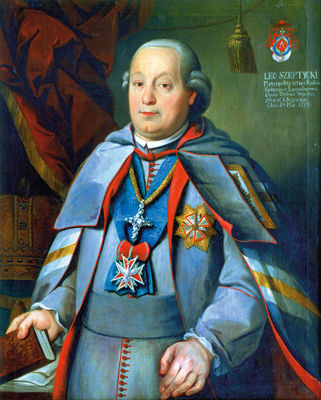5. Restoration of the Galician Metropolitanate 1808
 Metropolitan Lev Sheptytsky. Artist Luka Dolyns’ky
The strengthening of Ukrainian (Ruthenian) Church in the Commonwealth did not last for long. After the weakening and division of the country in 1772, 1793 and 1795, the Russian Empire extended its power to neighbouring Ukrainian lands. The “Uniates” did not escape oppression and forced “conversion” to the Moscow Church. Over 1768–1796 Muscovite rule spread through right-bank Ukraine, in 1839 — to western Belarus and northern Volhynia, and in 1875 — the Chełm lands and Podlachia. The Orthodox Metropolitanate of Kyiv was subordinated to the Moscow Patriarchate in 1685–1686.
Metropolitan Lev Sheptytsky. Artist Luka Dolyns’ky
The strengthening of Ukrainian (Ruthenian) Church in the Commonwealth did not last for long. After the weakening and division of the country in 1772, 1793 and 1795, the Russian Empire extended its power to neighbouring Ukrainian lands. The “Uniates” did not escape oppression and forced “conversion” to the Moscow Church. Over 1768–1796 Muscovite rule spread through right-bank Ukraine, in 1839 — to western Belarus and northern Volhynia, and in 1875 — the Chełm lands and Podlachia. The Orthodox Metropolitanate of Kyiv was subordinated to the Moscow Patriarchate in 1685–1686.
Meanwhile, the idea of Orthodox-Catholic church unity gained more supporters in the western part of Ukraine. At the Uzhhorod Council of 1646 a part of the clergy from the Eparchy of Mukachevo, an area which for centuries was under Hungarian rule, decided to restore communion with Rome.
The Uzhhorod Union was built along the lines of the Union of Brest. The most important provisions of the Union were the opposition to the spread of Protestantism and the desire to equalize rights with Roman Catholics.
However, the Council’s resolutions were realized only in the mid-18th century, after all of Transcarpathia came under the rule of the Austrian Habsburg monarchy.
The educational policy of the Habsburgs was critically important in changing the nature of the relationship between Christians of different traditions — first in Transcarpathia and later in Galicia, which after the first partition of Poland (1772) passed to the Austrian monarchy.
The Greek-Catholic hierarchy (as the Uniates began to be referred to on the order of Queen Maria Theresa with regard to their Eastern — “Greek” — ritual and Western — “Roman” — jurisdictional allegiance) gained the recognition and support of the Imperial government. The recognition resulted in the formal equation of rights with the Roman Catholics, unrestricted access to general and religious education, including in their native language, ensured minimum financial support, and organizational design of church administrative structures. In 1771, the Mukachevo diocese (from which the Archeparchy of Prešov was excluded in 1818) was legalized.
1808 saw the restoration of the Galician Metropolitanate with the center in Lviv.
The Habsburg reforms strengthened the principles of tolerance, respect for freedom of conscience, and the integration of Ukrainian Christians and their religious structures into public and political life.
The Greek-Catholic Church in Galicia played a special role in the Ukrainian national movement. Although most of the Greek-Catholic clergy were polonized in the late 18th — early 19th century, some of the lower clergy and seminarians under the influence of the “Ruthenian Triad” — Markiyan Shashkevych, Ivan Vahylevych and Yakiv Holovatsky, drew public attention to the common people in the 1830’s. The educated strata wanted to discover their historical identity, cultural heritage and social needs, and promoted the idea of one Ruthenian nation, different from both Poles and Russians, but divided between two empires.
This idea laid the foundation of the political platform of the first national institutions that emerged during the revolution of 1848–1849 on the initiative and under the leadership of Greek-Catholic hierarchy: the Supreme Ruthenian Council, Galician-Rus’ Matytsi society (literary and educational society whose purpose was educational activities through Ukrainian church schools, publishing books, etc.), Narodnyi Dim (People’s House) Cultural Centers. 1868 saw the creation of the society Prosvita, (Enlightenment), which engaged the Ukrainian peasantry in educational work.
Every town and village had local chapters of Prosvita with reading rooms led by local priests. The most prominent Ukrainian socio-political and cultural figures were often members and alumni of this organization.